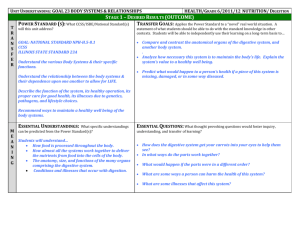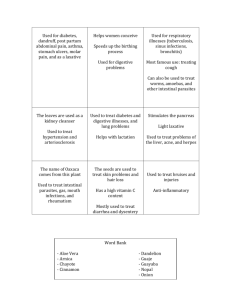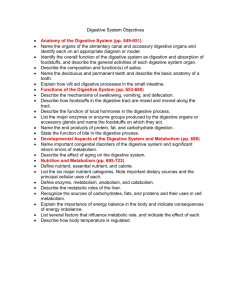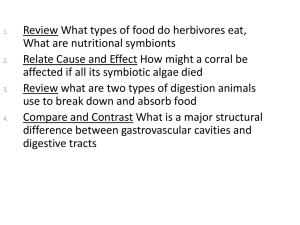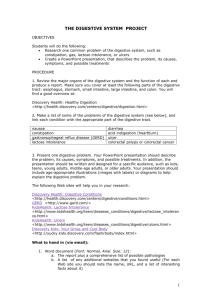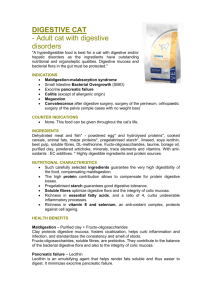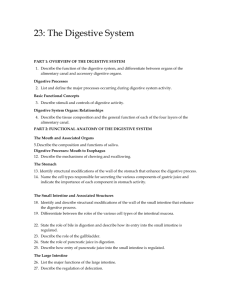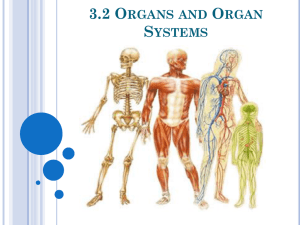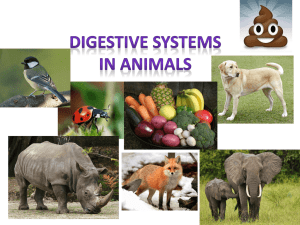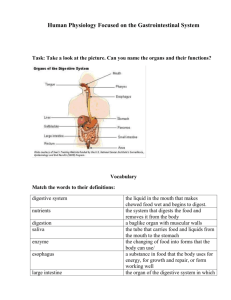UbD Nutrition & Digestion (NPH-H5-8.3)
advertisement
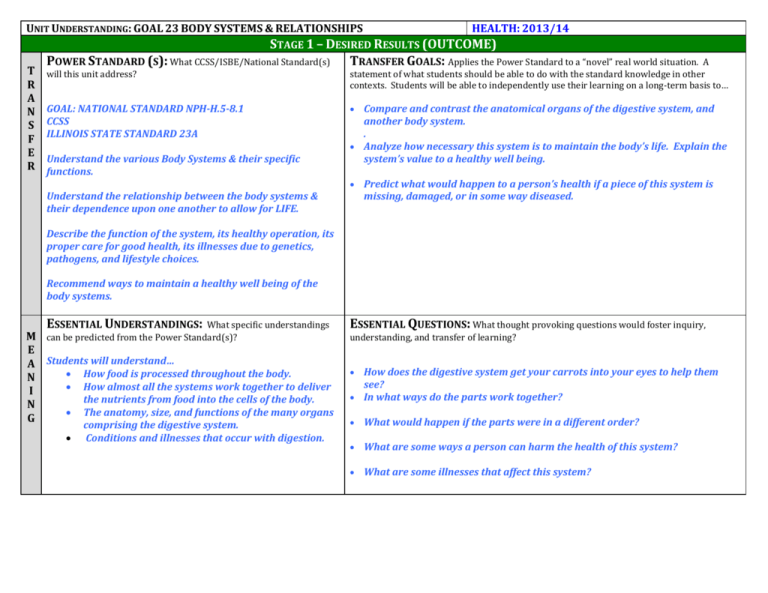
UNIT UNDERSTANDING: GOAL 23 BODY SYSTEMS & RELATIONSHIPS T R A N S F E R HEALTH: 2013/14 STAGE 1 – DESIRED RESULTS (OUTCOME) POWER STANDARD (S): What CCSS/ISBE/National Standard(s) TRANSFER GOALS: Applies the Power Standard to a “novel” real world situation. A statement of what students should be able to do with the standard knowledge in other contexts. Students will be able to independently use their learning on a long-term basis to… will this unit address? GOAL: NATIONAL STANDARD NPH-H.5-8.1 CCSS ILLINOIS STATE STANDARD 23A Understand the various Body Systems & their specific functions. Understand the relationship between the body systems & their dependence upon one another to allow for LIFE. Compare and contrast the anatomical organs of the digestive system, and another body system. . Analyze how necessary this system is to maintain the body’s life. Explain the system’s value to a healthy well being. Predict what would happen to a person’s health if a piece of this system is missing, damaged, or in some way diseased. Describe the function of the system, its healthy operation, its proper care for good health, its illnesses due to genetics, pathogens, and lifestyle choices. Recommend ways to maintain a healthy well being of the body systems. ESSENTIAL UNDERSTANDINGS: What specific understandings M can be predicted from the Power Standard(s)? E A Students will understand… How food is processed throughout the body. N How almost all the systems work together to deliver I the nutrients from food into the cells of the body. N The anatomy, size, and functions of the many organs G comprising the digestive system. Conditions and illnesses that occur with digestion. ESSENTIAL QUESTIONS: What thought provoking questions would foster inquiry, understanding, and transfer of learning? How does the digestive system get your carrots into your eyes to help them see? In what ways do the parts work together? What would happen if the parts were in a different order? What are some ways a person can harm the health of this system? What are some illnesses that affect this system? KNOWLEDGE: What should students know as a result of this unit? What can be studied? (Theory/Concepts/Mental Coordination) A C Q U I S I T I O N Students will know… Anatomy & Physiology of the Digestive System The relationship between the sense of taste/hot & cold, digestion, muscle movement, circulation, respiration, and excretion. SKILLS: What should students be able to do as a result of this unit? What can be practiced? (Application of Theory/Concepts/Physical Coordination) Students will be able to… Construct cause and effect relationships within and between the body systems. Compare and contrast anatomical parts and their physiology. Check validity of resources; ie. Textbook, publications, and internet services. Make inferences when describing various lifestyle choices & their effects. Evaluate their understanding STAGE 2 –EVIDENCE (ASSESSMENT) SUMMATIVE PERFORMANCE TASK(S): Is each standard and transfer goal being assessed? An authentic assessment(s) designed to show how students demonstrate their understanding of essential questions and transfer goals when applied to a new, varied, or realistic situation. Should be written in the GRASPS format and reflect the UbD “Six Facets of Understanding.” 1. List the body systems & explain the functions of each. 2. Interpret graphs relating to specific body systems and describe trends. 3. Relate various conditions to one’s own experience in small group discussion. 4. Recommend ways to maintain a healthy well being regarding the system. ASSESSMENT CRITERIA: What criteria will be used in each assessment to evaluate attainment of each desired result? What are the qualities by which learning is judged? Accurately & verbally, explain the functions of various systematic organs. In a daily journal, in-depth, describe the role of the digestive system, and/or another system of choice. With a small group, determine a person’s healthy and unhealthy habits, and make recommendations. Demonstrate a specific function of the system, using analogies, activities, smartboard exercises. FORMATIVE ASSESSMENT EVIDENCE: What daily evidence has been collected to determine goal attainment? Tests, quizzes, discussions, homework, exit slips, graphic organizers, note-taking, etc… Exit slips Diagram quiz Video questionnaire(POST-viewing) Spot-check, random questioning STAGE 3 – LEARNING PLAN (ACTIVITY) PRE-ASSESSMENT: What will be done to determine students’ background knowledge, skill level, and possible misconceptions? (K-W-L) How will students be grouped? What opportunities for differentiation will take place? - Students will discuss system understanding using paired & triad discussion. - View a short video clip, “Inside Story” and discuss the dissection. - Class discussion ALIGNED LEARNING ACTIVITIES: What will be done each day to foster student success at transfer, meaning, and acquisition? How will critical thinking, problem solving, and systems thinking be incorporated? Consider the “Gradual Release of Responsibility Model” and “WHERETO” format when developing daily experiences linked to Stages 1 and 2. DATE(S) “WE WILL…” OBJECTIVE: How are action verbs used to link content to the Power Standard for each learning experience? We will identify the anatomy & physiology of the digestive system. PROCEDURES: PROGRESS MONITORING: …….continued. …continued. Using the life-size model, rearrange the parts of the digestive system, allowing the students time to discuss the problems that would occur if this were real. Have them pretend to be a surgeon who can correct this malformation. Discuss the cause & effects of various digestive conditions and ways to maintain healthy digestion. Using the Question of the Day, small group answering sessions, determine that students understand the effects of missing or damaged parts, and see that they can reconfigure the system in its proper order. When using the smartboard, ask random questions, selecting random students to expose the part of the system to check for accuracy. During the peristalsis activity, ask spot check questions to be answered in the vicinity of the digestive area of the fabric tubes. Using the smartboard, select randomly students to label the digestive system parts. During reflection time, have students offer their ‘most important’ finding for the class. What is the daily lesson plan process? What is the step-by-step path of learning? How are learning activities prioritized and sequenced in an engaging and time sensitive manner? How are learning experiences differentiated or modified to meet assessed learning needs? How are the daily products connected to Summative Performance Tasks? Using a 27-foot clothesline/twine strung across the room, demonstrate the life-size model of the digestive tract. With each part of the system hung onto the line, ask leading questions which engage the students in paired discussion. When the entire system is complete, challenge each student to list the parts, in order, without looking at the model. How is progress toward transfer, meaning, and acquisition regularly monitored? What are the misunderstandings? How will students receive relevant feedback? With the class discussion, students have opportunity to answer many questions with their partner. Listening in on these discussions will allow for misconceptions to be discussed on a larger scale, in the general class explanation. …continued. We will interrelate the digestive system and other systems using a discussion, activity, and competition. Using the SmartBoard, Select various students, randomly, to expose the parts of the system with the labels Demonstrate, using fabric tubes, how the muscular system aids in digestion with the “peristaltic wave”. Students sit side by side holding the fabric tube & when a marble progresses through it, their hands act like the smooth muscles that create the wave. Teamwork is important, because the tube is 27-feet long. Ask questions during the game that foster understanding the interrelationship of the muscular system and digestive system. Create a competition between two sides of the room. When finished, select random students to place the labels of the parts onto the smartboard diagram. show “The Inside Story”, a 14-minute video which applies student’s knowledge using a pig dissection, acid/disolving experiment, and skulls/teeth demonstration. When finished, explain how the digestive system, while important, cannot function, if it is NOT connected to the rest of the organism, ie: themselves. Brief exit slip with five questions relating to the video will be previewed prior to video, and then answered during and post viewing. Trade/Grade/Discuss.
